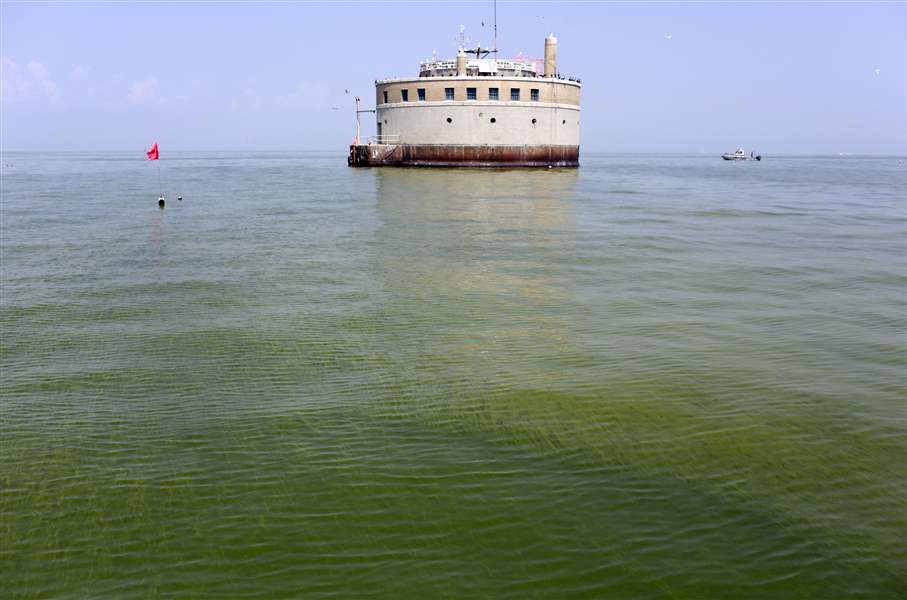
Lake Erie clean-up measure nearing governor's desk
6/19/2018
In this August, 2014 photo, the water intake crib for the city of Toledo is surrounded by an algae bloom on Lake Erie, about 2.5 miles off the shore of Curtice, Ohio.
ASSOCIATED PRESS
COLUMBUS — A measure to put $36 million in state funds behind efforts to stem the flow of the nutrient runoff fueling the toxic green slime that annually plagues Lake Erie is expected to reach Gov. John Kasich’s desk by month’s end.
The House Finance Committee voted unanimously Tuesday to send the full chamber House Bill 643, sponsored by Reps. Steve Arndt (R., Port Clinton) and John Patterson (D., Jefferson). It would fund research, help farmers reduce fertilizer runoff from their fields, find beneficial uses for sediment dredged from ports and harbors, and support local soil and water conservation districts.
But it remains to be seen whether that bill or a similar measure unanimously passed by the Senate two weeks ago will reach the governor. The committee will start hearings on Senate Bill 299, sponsored by Sens. Randy Gardner (R., Bowling Green) and Sean O’Brien (D., Cortland), on Wednesday.
While the so-called Clean Lake 2020 Plan would put more money behind voluntary efforts to reduce phosphorous, Environmental Protection Agency Director Craig Butler told the committee such efforts haven’t moved the needle in terms of helping Ohio meet its commitment with Michigan and Ontario to reduce phosphorous runoff by 40 percent by 2025.
“While I’m encouraged that the legislature has been engaged in Lake Erie, I’m concerned that Ohio is not seeing the progress toward that reduction goal of 40 percent of phosphorous that we would have expected to see from all the voluntary initiatives and regulatory actions that we have taken to date,” he said.
RELATED: Toledo's Ottawa River takes another big step in its long healing process
Mr. Butler continues to advocate for tougher steps beyond existing law that encourages farmers to voluntarily adopt practices to reduce manure and commercial fertilizer runoff.
He wants to take statewide the maximum phosphorous discharge limit already applied to many wastewater treatment plants on the lake and to change the definition of “agricultural pollution” to include fertilizers so that the Department of Agriculture may mandate action by farmers when a watershed is declared to be distressed.
“It took us a generation frankly to impact the lake negatively,” he said. “It’s going to take us a significant amount of time…to have a positive impact, although I think you will see incremental impacts over time,” Mr. Butler said. “That 40 percent reduction number is not that we will eliminate this problem entirely but that on any given year we stand a pretty good chance of not having a really bad year.”
Predictions for this year expect a sizeable bloom but not as large as last year. Algal growth typically peaks in August to mid-September.
There’s been talk that, absent legislative action, Mr. Kasich may act on his own via executive order.
House Bill 643 would provide:
● $2.65 million to the Ohio State Sea Grant and Stone Lab to research and monitor phosphorous loading, harmful algal growth, and toxicity levels.
● $10 million to help find alternative uses for dredged sediment other than dumping it into the open lake.
● Up to $20 million to state entities to help provide grants and loans for equipment and other assistance to farmers to reduce phosphorous levels running off their fields. No single project could exceed 40 percent of the funds.
● $3.5 million to support soil and water conservation districts in the lake’s western basin.
Lawmakers are not expected to act before recessing for the summer on a separate resolution that would ask voters to approve the borrowing of $1 billion — $100 million a year for 10 years — to invest in wastewater and water treatment plants, water quality research, and water resource management.
Contact Jim Provance at: jprovance@theblade.com or 614-221-0496.